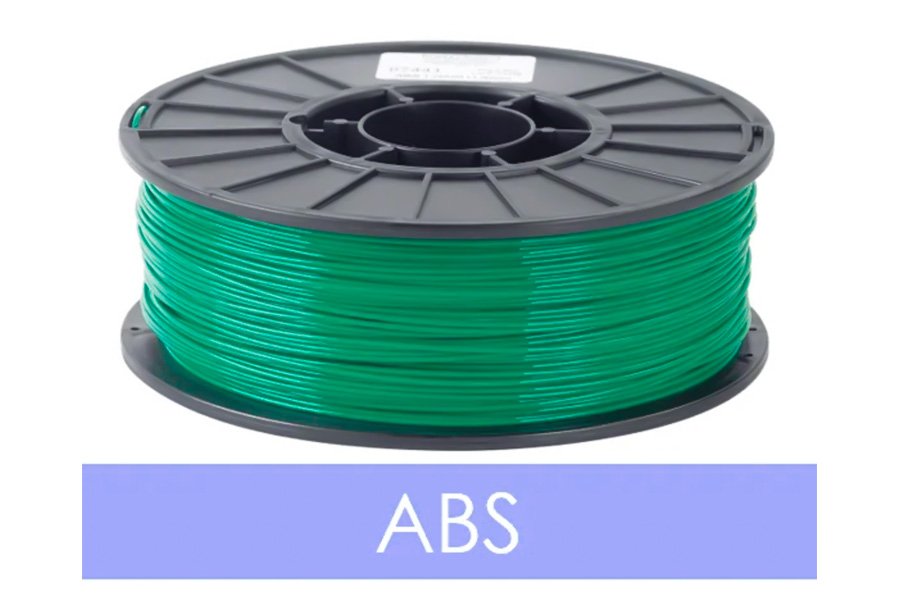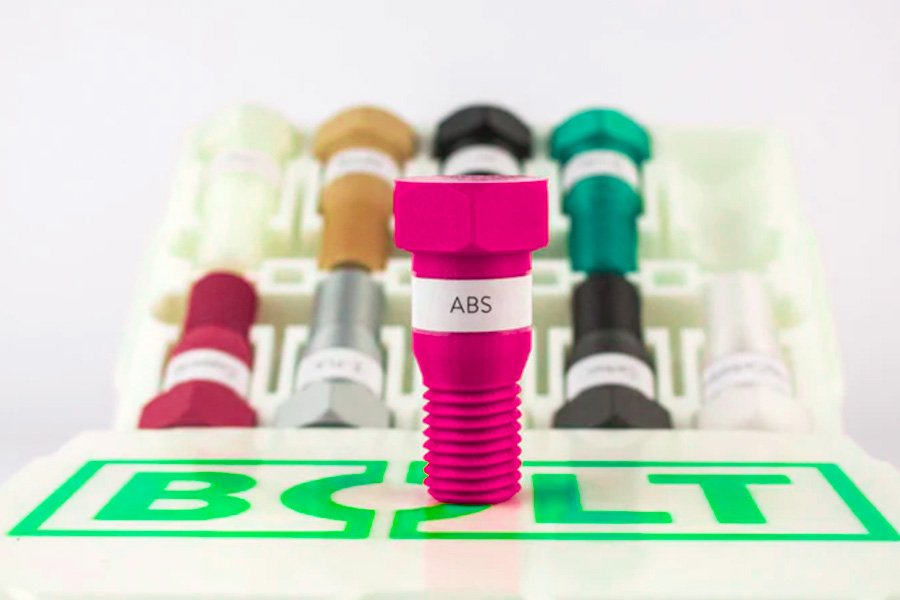ABS, short for acrylonitrile butadiene styrene, is one of the most commonly used filaments in 3D printing. It is widely used to make plastic parts that require both strength and stability in temperature changes. Next, let’s take a closer look at the composition, wide range of applications, and unique properties of ABS, and compare its performance with other common filaments.
What is ABS Filament?
ABS is a thermoplastic polymer that is very commonly used in fused deposition modeling (FDM) 3D printing technology. It is composed of three monomers. Since it was patented in 1948, ABS has quickly gained widespread recognition and application. Due to its high strength, good flexibility and plasticity, ABS is widely used in many fields, whether it is pipes or toys. As a 3D printing material, ABS has excellent processing performance, high durability, and high printing efficiency.
At the same time, it can withstand high temperatures, has excellent melt fluidity, and has good strain and wear resistance. To prepare ABS, three main monomers, acrylonitrile, styrene and butadiene, need to be polymerized. Among them, acrylonitrile provides rigidity, strength and chemical resistance to ABS; styrene gives it a smooth and shiny surface; and butadiene, as a rubber element, enhances the toughness of ABS.

What are the advantages and disadvantages of ABS filament?
Advantages of ABS:
- Excellent impact resistance: ABS plastic is highly praised for its excellent impact resistance, especially for applications that require high durability and toughness.
- High strength and stiffness: ABS has good mechanical properties, showing high strength and high stiffness, and can withstand large loads and stresses, making it very suitable for the manufacture of structural parts.
- Processing versatility: ABS plastic is a material with great processing flexibility and can be easily formed through a variety of processes such as injection molding, machining and 3D printing.
- Good chemical resistance: The material has excellent resistance to chemicals such as acids, alkalis and various solvents.
- Excellent electrical insulation: ABS plastic has good electrical insulation properties, so it is often used in the manufacture of electrical and electronic components, housings and other parts.
- Easy surface treatment: ABS plastic is easy to finish and post-process, and can easily obtain a smooth and beautiful surface effect.
Disadvantages of ABS:
- Weather resistance is poor: ABS materials are prone to aging and degradation under sunlight and ultraviolet radiation. Long-term exposure will cause it to become brittle and fade, which limits its application in outdoor environments.
- High flammability: ABS plastic is a flammable material with relatively low fire resistance. It is easy to melt and burn and may release toxic fumes. Its fire resistance can be improved by adding flame retardants.
- Limited heat resistance: ABS materials have a relatively low melting point, usually between 200-240°C (392-464°F). At higher temperatures, it may deform or lose mechanical properties, which limits its application range.
- Poor dimensional stability: Compared with other engineering plastics, ABS has a larger thermal expansion coefficient, which makes it easy to change its size when the temperature changes, and it is difficult to maintain precise tolerances.

How are ABS parts made?
ABS plastic parts can be produced using a variety of manufacturing processes. The ideal production method is influenced by the quantity required, the geometry, and the properties required of the part. Some common methods include:
- Injection molding: Injection molding is the most common process used to manufacture ABS plastic parts. This service is suitable for producing large quantities of complex parts with precise dimensions and intricate details.
- CNC machining: The material can also be machined using a computer numerically controlled (CNC) mill or lathe. CNC machining is suitable for producing small batches or custom ABS parts with tight tolerances.
- 3D Printing: ABS plastic is a popular material for 3D printing, especially with FDM (fused deposition modeling) 3D printers. There are also many ABS-like materials that can be used for SLA 3D printing. This allows for the production of complex geometries and prototypes with relatively low setup costs compared to traditional processes such as injection molding.
- Extrusion: ABS can be extruded into continuous profiles such as tubes, rods, and sheets. Extruded ABS can be cut into specific lengths to produce parts.

What are the best industrial applications for ABS filament?
Automotive Industry
The ABS filament is widely used in the automotive industry because it is lighter yet stronger as compared to other plastics. The use of ABS filament reduces the overall weight of the vehicle by 10 percent, thus making the vehicle fuel-efficient. Most manufacturers use ABS filament to make wheel covers and dashboards.
Pipes and Fittings
The pipes and fittings manufacturing industries extensively use ABS as the popular filament for 3D printing. The reasons for its popularity are that it is light-weight, has a very low-temperature melting point, and is highly reliable. The filament can also withstand wear and tear and is easy to install and maintain. This makes it a great choice for creating prototypes of pipes and fittings.
Toy Industry
The toy industry also prefers the ABS filament as it is highly durable and can withstand high temperatures. Also, the ABS filament is less brittle as compared to its counterparts and hence forms a great material to make toys that are safe for children.
Sports Equipment
For sports equipment, manufacturers prefer using the ABS as filament for 3D printers because of its durability and ability to withstand pressure. ABS filament is used to manufacture products such as running shoes, bike helmets, golf masks, mouth guards, etc.
ABS vs. PLA vs. PETG: Which is Better?
When it comes to 3D printing, choosing the right filament is crucial to the success of your project. When comparing ABS, PLA, and PETG, it’s hard to say which one is “better” because each material has its own unique properties and applicable scenarios. Here’s a detailed comparison of the three materials:
What is PLA?
PLA (polylactic acid) is a thermoplastic derived from renewable resources such as corn starch or sugar cane. PLA is biodegradable under the right conditions and is one of the most popular bioplastics, making it ideal for a variety of applications, from plastic cups to medical implants.
What is PETG?
PETG is a transparent, non-crystalline copolyester material, which is obtained by introducing specific comonomers into PET through chemical modification. PETG has outstanding toughness and high impact strength, as well as good processing performance, mechanical strength and flexibility. In addition, PETG also has environmental advantages and is widely used in packaging, construction, electronics, automobiles and other fields.
| Material Properties | ABS | PLAN | PETG |
|---|---|---|---|
| Strength and toughness | High strength and toughness | Medium strength, slightly less tough | High strength and toughness |
| heat tolerance | Good heat resistance and high heat deflection temperature | It has poor heat resistance and is easy to soften at high temperatures | The heat resistance is good, and the heat deflection temperature is higher than that of PLA |
| Chemical resistance | Good chemical resistance | Chemical resistance is average | Good chemical resistance |
| Printing difficulty | Tall, warped, and requires high-temperature printing | Lower, easy to print | Medium, not easy to warp, but pay attention to the printing temperature |
| Eco-friendliness | In general, harmful gases may be generated when printing | Eco-friendly and biodegradable | Environmentally friendly, no harmful gases generated |
| Surface smoothness | Better, suitable for post-sanding and coloring | In general, more post-processing may be required | Very good, smooth surface and rich detail |
| transparency | opaque | opaque | Transparent or translucent |
| Application scenarios | Tools, mechanical parts, auto parts, etc | Handicrafts, decorations, children’s toys, etc | Transparent containers, decorations, items that require flexibility, etc |
Conclusion:
- If you need to make high-strength and high-toughness parts and have high requirements for heat resistance, then ABS may be a better choice.
- If you pay attention to environmental protection and need to make some decorations or handicrafts that do not require high strength, then PLA may be a better choice.
- If you need to make transparent containers or decorations and have certain requirements for strength, toughness and heat resistance, then PETG may be a better choice.

How to Successfully Print with ABS Filament?
To successfully use ABS filament for printing, you need to pay attention to the following aspects:
Equipment requirements:
- Heated bed: Make sure the heated bed temperature is set at 100-110°C to effectively prevent the ABS material from warping during printing.
- Enclosed structure: Use a printer with a closed structure, such as the Bambu Lab X1 Carbon, and maintain the chamber temperature at 50-60°C to provide a stable printing environment.
- Base treatment: Use PEI steel plate as the printing base, and use a glue stick (or Kapton tape) to enhance the adhesion between the ABS material and the base.
Parameter settings:
- Nozzle temperature: Set the nozzle temperature to 230-250°C to ensure that the ABS material can be melted smoothly and extruded evenly.
- Layer height: Choose a layer height of 0.15-0.25mm to strike a balance between print quality and print time.
- Cooling fan: Turn off the cooling fan when printing the first layer, and then turn it on but the wind speed should be kept below 10% to avoid interlayer separation caused by too fast cooling.
Anti-warping tips:
- Brim: Add a 5mm wide skirt to the edge of the model to increase the contact area between the model and the base plate and reduce the risk of warping.
- Reduce the printing speed: Reduce the outer wall printing speed to ≤30mm/s and the filling speed to ≤50mm/s to ensure that each layer can be fully bonded.
- Preheat the chamber: Heat the chamber for 10 minutes without load before printing to ensure that the temperature inside the printer is uniform and stable, providing the best environment for ABS printing.

LS uses a variety of materials for 3D printing
As a company specializing in the field of rapid prototyping and customized parts production, LS is committed to providing customers with high-quality 3D printing solutions.In addition, we can provide various types of 3D printing materials you may need, such as ABS, PLA and PETG, Nylon mentioned in this article. Choosing the right material is essential to creating customized prototypes and parts that meet the required mechanical properties, functions and appearance requirements. You can check out LS’s 3D printing material basics to choose the right material for your final part.Get an instant quote using our online tool and start your 3D printing journey!For more details, feel free to contact us through our page.
Conclusion
ABS filament is a polymer material made of three monomers: acrylonitrile, butadiene and styrene. It is widely used in the field of 3D printing. It has good mechanical properties, heat resistance, impact resistance and easy processing, and is suitable for making various strong and useful 3D printed parts. By understanding its basic characteristics, application fields, printing advantages and precautions for use, we can better use this material to print high-quality parts and products.
Contact us now to get exclusive CNC machining solutions!



Disclaimer
The content appearing on this webpage is for informational purposes only. LS makes no representation or warranty of any kind, be it expressed or implied, as to the accuracy, completeness, or validity of the information. Any performance parameters, geometric tolerances, specific design features, quality and types of materials, or processes should not be inferred to represent what will be delivered by third-party suppliers or manufacturers through LS’s network. Buyers seeking quotes for parts are responsible for defining the specific requirements for those parts. Please contact to our for more information.
Team LS
This article was written by various LS contributors. LS is a leading resource on manufacturing with CNC machining, sheet metal fabrication, 3D printing, injection molding,metal stamping and more.
FAQs
What is ABS filament?
ABS filament is a thermoplastic filament made by copolymerization of three monomers: acrylonitrile (A), butadiene (B) and styrene (S). It has good mechanical properties such as high strength, high toughness and impact resistance, and excellent heat resistance and processability. Therefore, ABS filament is widely used in the field of 3D printing to manufacture parts with various complex shapes and functions.
Is ABS stronger than PETG?
ABS and PETG have their own characteristics in terms of strength, and it cannot be simply said that ABS is stronger than PETG. ABS has higher strength and toughness, but the interlayer adhesion may be poor; PETG has good interlayer strength and better weather resistance. The choice of which material should be determined according to the specific application scenario and needs.
Is ABS filament better than PLA?
ABS filament and PLA filament are both commonly used materials in 3D printing. They each have their own advantages, and we cannot simply say that ABS is better than PLA. ABS filament has higher strength and toughness, and better heat resistance, making it suitable for manufacturing parts that need to withstand certain loads and high temperatures. However, ABS filament is relatively difficult to print, prone to warping, and requires higher printing temperatures and heated beds, as well as a good ventilation environment to avoid the influence of odor and smoke. In contrast, PLA filament is less difficult to print, less prone to warping, and is environmentally friendly and biodegradable. However, PLA filament has relatively low strength and heat resistance, and is not suitable for manufacturing parts that need to withstand high loads and high temperatures. Therefore, the choice of ABS or PLA filament should be determined based on specific application scenarios and needs.
What are the disadvantages of ABS filament?
Although ABS filament has many advantages, it also has some disadvantages. First, ABS filament is prone to warping during printing, which is mainly caused by its uneven shrinkage during cooling. In order to solve this problem, some measures need to be taken, such as using a heated bed, adjusting the printing temperature, etc. Secondly, ABS filament will produce odor and smoke during printing, which may have a certain impact on human health. Therefore, when printing ABS filament, it is necessary to ensure that the room is well ventilated and wear appropriate protective equipment. In addition, ABS filament is also highly hygroscopic and easily absorbs moisture in the air, resulting in a decrease in printing quality.Therefore, before using ABS filament, it needs to be dried to ensure that its moisture content is within a reasonable range. Finally, ABS products exposed to sunlight for a long time are prone to aging, discoloration and performance degradation, so attention should be paid to its weather resistance.



Great line up. We will be linking to this great article on our site. Keep up the good writing.
Thank you for your support, each article is written by ourselves, we will update the article every day, you can subscription LS, wish you a happy day.